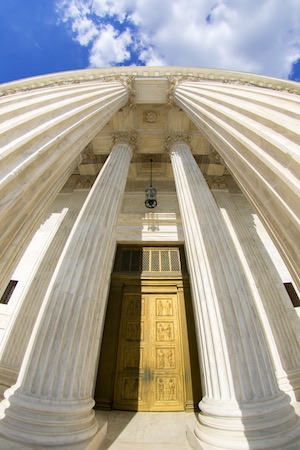PTAB Strategies and Insights Newsletter – May 2023: Kyocera and the Brewing Debate Over Expert Qualifications at the PTAB | Sterne, Kessler, Goldstein & Fox P.L.L.C.
Technical experts play a key role in patent litigation, including in PTAB litigation. Indeed, experts are often the only witnesses to provide testimony in PTAB proceedings, and final written decisions often hinge on which party’s expert the PTAB panel finds more credible. This article explores recent developments in the required qualifications of a technical expert and an important, unresolved question: to qualify as a technical expert and provide opinions from the perspective of a skilled artisan, is the expert required to have possessed ordinary skill at the time of the invention?
In January 2022, the Federal Circuit issued its decision in Kyocera Senco Industrial Tools Inc. v. International Trade Commission, holding that, “to be qualified to offer expert testimony on issues from the vantage point of an ordinarily skilled artisan in a patent case, an expert must at a minimum possess ordinary skill in the art.”[1] Prior to this decision, it was unclear whether an expert was required to possess ordinary skill in the art to testify from the perspective of a skilled artisan. For example, the Federal Circuit’s 2008 decision in Sundance, Inc. v. DeMonte Fabricating Ltd. held “[a] witness possessing merely ordinary skill will often be qualified to present expert testimony both in patent trials and more generally,” but did not require an expert to possess ordinary skill.[2] And district courts were split on the issue.[3] So while Kyocera settled the issue of whether ordinary skill is required, the court did not answer the question of when the ordinary skill must have been attained.
In the wake of Kyocera, PTAB panels have applied its holding and accorded no weight to testimony from experts who do not possess ordinary skill. For example, in the institution decision in Avail Medsystems, Inc. v. Teladoc Health, Inc., the panel gave no weight to an expert’s “testimony from the perspective of a skilled artisan” because the expert lacked the specific experience with teleconferencing systems required under the adopted definition of a skilled artisan.[4] Similarly, the panel’s final written decision in Incyte Corp. v. Concert Pharmaceuticals, Inc. gave no weight to expert’s opinions “with regard to issues of treating hair loss disorder” because the expert lacked the specific experience with such issues that were required under the adopted definition of the skilled artisan.[5]
That said, PTAB panels have thus far been reluctant to disregard testimony from an expert who is currently a skilled artisan but was not at the time of the invention. Indeed, parties have challenged opposing expert qualifications where the expert had not attained ordinary skill in the art until after the time of the invention of the relevant patents.[6] But panels have rejected these challenges due to a lack of “authority that a witness must qualify as an ordinarily skilled artisan at the time of the invention in order to testify about the perspective of such a person.”[7]
In view of Kyocera, should the admissibility of expert testimony from the perspective of a skilled artisan require such a time constraint? That is, is an expert qualified to testify from the perspective of a skilled artisan as of a particular date if the expert was not a skilled artisan as of that date?
Many patent-related issues, including infringement, validity, and claim construction, are “analyzed in great part from the perspective of a person of ordinary skill in the art.”[8] This is in large part to help the factfinder “focus on conditions as they existed when the invention was made.”[9] Indeed, in an obviousness analysis, “[t]he primary value in the requirement that level of skill be found lies in its tendency to focus the mind of the decisionmaker away from what would presently be obvious to that decisionmaker and toward what would, when the invention was made, have been obvious, as the statute requires, ‘to one of ordinary skill in the art.’”[10] This is because “[k]nowledge after the event is always easy, and problems once solved present no difficulties, indeed, may be represented as never having had any.”[11]
Thus, “testimony explaining the technical evidence” from the perspective of a skilled artisan “may be of great utility to the factfinder” in determining the “beliefs of those in the field at the time,” as well as “the then-accepted wisdom in the field.”[12] Kyocera held that expert testimony from persons who do not possess ordinary skill in the art is “neither relevant nor reliable” because the testimony is not “based on any specialized knowledge, training, or experience that would be helpful to the factfinder.”[13] Thus, testimony from a person who does not possess ordinary skill is not a reliable indicator of the conditions at the time of the invention, and “serves only to cause mischief and confuse the factfinder.”[14]
It may be reasonable to extend Kyocera’s logic to scenarios where the expert first attained ordinary skill after the invention of the relevant patent. An expert who did not grapple with the challenges and issues faced by those in the field at the relevant time may not be able to reliably describe the mindset of a skilled artisan at that time. Such experts are susceptible to improper hindsight, just as factfinders are.[15] This is especially true when the expert acquired skilled artisan status long after the relevant date or where the technical field is a rapidly evolving one.
It is worth noting that a line of pre-Kyocera district court case law holds that an “expert must be qualified to testify about what a person with ordinary skill in the art must have understood at the time of the invention, but the expert’s knowledge of that may have come later.”[16] These cases have generally held that the timing of the expert’s status as a skilled artisan “goes to the weight of the evidence, not its admissibility.”[17] One court held that requiring such a strict time constraint is, “as a practical matter,” a “burdensome” and “unnecessary hurdle.”[18]
But is there really much of a difference between (1) an expert who is currently a skilled artisan but was not a skilled artisan in the relevant time period and (2) an expert who was never a skilled artisan? In both cases, the experts have no firsthand knowledge of what skilled artisans understood in the relevant time period and needed to obtain such knowledge from other sources. Moreover, current knowledge in a field, particularly in rapidly changing fields, is not necessarily relevant to the time period at issue. For example, consider fast-changing fields like quantum computing or genome editing. How much is current knowledge of these fields relevant to techniques that existed, say, 20 years ago?
Nevertheless, in view of Kyocera, it is still an open question whether such a time constraint is necessary for the consideration of expert testimony from the perspective of a skilled artisan. For the time being, it appears that PTAB panels are generally unwilling to extend the Kyocera ruling to require such a limitation. Unless and until further guidance is handed down by the Federal Circuit, parties at the PTAB would be wise to frame such challenges as an issue of weight of the evidence, rather than its admissibility.[19]
[1] Kyocera Senco Indus. Tools, Inc. v. Int’l Trade Comm, 22 F.4th 1369, 1377 (Fed. Cir. 2022).
[2] Sundance, Inc. v. DeMonte Fabricating Ltd., 550 F.3d 1356, 1363 (Fed. Cir. 2008).
[3] See Plexxikon Inc. v. Novartis Pharms. Corp., No. 17-CV-04405-HSG, 2020 WL 1455830, at *2-3 (N.D. Cal. Mar. 25, 2020).
[4] Avail Medsystems, Inc. v. Teladoc Health, Inc., IPR2022-00444, Paper 10, 22-26, 28-29, 31 (P.T.A.B. July 21, 2022).
[5] Incyte Corp. v. Concert Pharms., Inc., PGR2021-00006, Paper 68, 8-9 (P.T.A.B. May 11, 2022).
[6] Hanwha Solutions Corp. v. Rec Solar Pte. Ltd., No. IPR2021-00989, Paper 22, 7-13 (P.T.A.B. Mar. 13, 2022); Scentair Techs., LLC v. Prolitec, Inc., No. IPR2021-00012, Paper 8, 9-10 (P.T.A.B. Jan. 19, 2021).
[7] Scentair Techs., LLC, IPR2021-00012, Paper 22 at 61.
[8] Sundance, 550 F.3d at 1361; see also Kyocera, 22 F.4th at 1377.
[9] Arkie Lures, Inc. v. Gene Larew Tackle, Inc., 119 F.3d 953, 956 (Fed. Cir. 1997).
[10] Kloster Speedsteel AB v. Crucible Inc., 793 F.2d 1565, 1574 (Fed. Cir. 1986).
[11] Diamond Rubber Co. of N.Y. v. Consol. Rubber Tire Co., 220 U.S. 428, 435 (1911).
[12] Sundance, 550 F.3d at 1361; Arkie Lures, 119 F.3d at 957; In re Kotzab, 217 F.3d 1365, 1369 (Fed. Cir. 2000).
[13] Kyocera, 22 F.4th at 1377.
[14] Sundance, 550 F.3d at 1362.
[15] See Diamond Rubber, 220 U.S. at 435 (“expert witnesses may be brought forward to show that the new thing which seemed to have eluded the search of the world was always ready at hand and easy to be seen by a merely skillful attention”).
[16] Disney Enters., Inc. v. Kappos, 923 F. Supp. 2d 788, 799 (E.D. Va. 2013).
[17] Asahi Glass Co. v. Guardian Indus. Corp., Case No. CIV.A. 09-515-SLR, 2011 WL 4459606, *1 (D. Del. Sept. 26, 2011).
[18] Anglefix, LLC v. Wright Med. Tech., Inc., No. 13-CV-2407-JPM-TMP, 2017 WL 2973989, *3 (W.D. Tenn. July 12, 2017).
[19] See Yorkey v. Diab, 601 F.3d 1279, 1284 (Fed. Cir. 2010).






